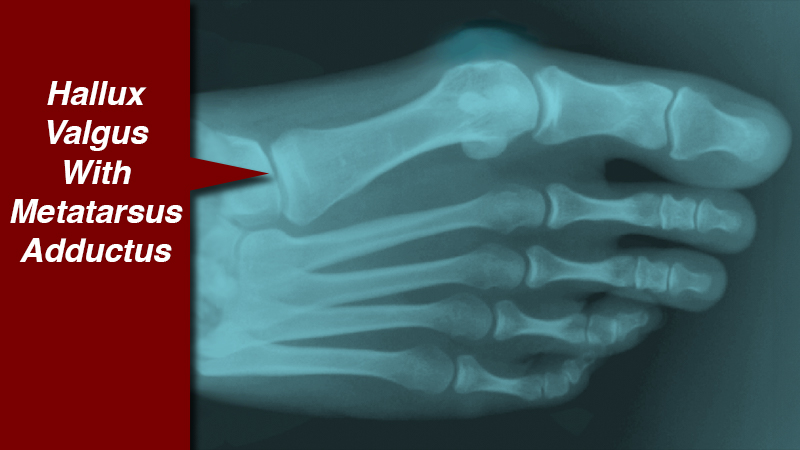
Practice Perfect 922
Hallux Valgus With Metatarsus Adductus - Should We Do Surgery for Both? Part 1 - Is There a Relationship?
Hallux Valgus With Metatarsus Adductus - Should We Do Surgery for Both? Part 1 - Is There a Relationship?

For the majority of my career, I’ve been vexed by a particular problem with no apparent solution: metatarsus adductus. Like everyone in podiatry, I was taught a number of surgical options in school, and I was trained to perform a number of them in residency. However, I was never satisfied with these procedures. They were too long and, often, too difficult. The results were too variable. So, outside of some very specific indications, I’ve avoided reconstructing metadductus (MA), especially when it comes to bunions.
As a short preamble for what we’ll discuss today, I’ll relate that my go-to procedure currently for patients with severe hallux valgus with metatarsus adductus is the first MTP joint arthrodesis. I’ve been almost universally happy with the outcomes…almost. I have had a few cases over the years where the MA was significant enough that I would have rather fixed the deformity and, possibly, not fuse the first MTP joint. I don’t have any patients unhappy with their results – at least, none that came back to me – so I haven’t had a lot of motivation to change my protocols. But, in a few cases, I really would have rather repaired the deformity that caused the hallux valgus in the first place.
I’ll state in short form a couple of my issues with the “older” MA procedures:
1. Dorsal dissection isn’t the easiest (not really a major issue, but it can become one for a patient with a painful bunion that then has a larger reconstruction and has issues with the MA repair later).
2. Older procedures have an increased risk of metatarsal heads landing on different sagittal plane levels, leading to postoperative complications. Yuck.
Then along comes some very interesting work in the literature about an instrumented approach to this problem that I find very interesting.1 I’m not biased toward or paid by any surgical company, so the rest of this discussion will be as generic as I can make it.
As a result of all this, I am investigating whether or not I want to dip my surgical toes into this pool and start doing these procedures. To that end, I’m asking three primary questions, and we’ll see what the research shows.
- Is there a clinically significant causal relationship between metatarsus adductus and hallux valgus?
- Does correction of metatarsus adductus lead to important improvements in hallux valgus surgery?
- How does one decide to concurrently fix metatarsus adductus when repairing hallux valgus?
Today, we’ll discuss the first question and leave the answer to the second and third questions for next week.
Is there a clinically significant causal relationship between metatarsus adductus and hallux valgus?
For those of you who are impatient, I’ll say the answer from the literature seems to be…maybe.
In a study by Cho, et al in the Journal of Foot and Ankle Surgery,2 they reviewed 186 patients with bilateral asymmetrical hallux valgus, some with and some without metatarsus adductus. They performed a number of different radiographic measurements and performed a multiple regression analysis. They found changes in the intermetatarsal and sesamoid rotation angles correlated with increased hallux abductus angle in both groups and stated, “progression of the hallux valgus deformity might be pathophysiologically different between those with and without metatarsus adductus.”
Ok, so what about that causal relationship? Aiyer and colleagues3 retrospectively examined 587 patients who underwent bunionectomy, and they reviewed the intermetatarsal, hallux abductus, and metatarsus adductus angles before and at final postop follow-up. They found radiographic recurrence of hallux abductus in 15% of patients without metatarsus adductus and 29.6% in patients with metatarsus adductus, irrespective of the procedure chosen. The authors stated metatarsus adductus increases the risk of recurrent hallux valgus. However, it should be noted that a retrospective study cannot confirm a causal relationship but rather only that there is a relationship (correlation, not causation).
Interestingly, a study by Dawoodi and Perera4 found a correlation between hallux valgus and metatarsus adductus on radiographs only when using the traditional metatarsus adductus angle (rather than a number of other methods). They determined that the relationship between the two was sensitive to the assessment method.
All in all, according to the literature it appears there could be a relationship between hallux valgus and metatarsus adductus, but the type of measurement matters. We can’t know for sure, unfortunately, because the methodology of these studies is not set up to completely answer this question. Maybe we’ll have more answers when we discuss the more clinical questions next week.
Until then, Best wishes.

Jarrod Shapiro, DPM
PRESENT Practice Perfect Editor
[email protected]

-
McAleer JP, Dayton P, DeCarbo WT, Hatch DJ, Smith WB, Ray JJ, Santrock RD. A Systematic Approach to the Surgical Correction of Combined Hallux Valgus and Metatarsus Adductus Deformities. J Foot Ankle Surg. 2021 Sep-Oct;60(5):1048-1053.
Follow this link -
Cho SH, Chung CY, Park MS, Sung KH, Choi JH, Koo S, Lee KM. Intrasubject Radiographic Progression of Hallux Valgus Deformity in Patients With and Without Metatarsus Adductus: Bilateral Asymmetric Hallux Valgus Deformity. J Foot Ankle Surg. 2022 Jan-Feb;61(1):17-22.
Follow this link -
Aiyer A, Shub J, Shariff R, Ying L, Myerson M. Radiographic Recurrence of Deformity After Hallux Valgus Surgery in Patients With Metatarsus Adductus. Foot Ankle Int. 2016 Feb;37(2):165-171.
Follow this link -
Dawoodi AIS, Perera A. Reliability of metatarsus adductus angle and correlation with hallux valgus. Foot Ankle Surg. 2012 Sep;18(3):180-186.
Follow this link































Comments
There are 0 comments for this article